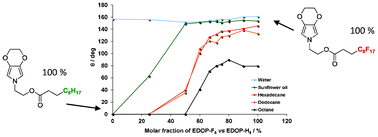To obtain superoleophobic properties, fluorinated compounds are necessary but they are toxic due to their bioaccumulative potential. This is why, in this article, we investigate superoleophobic materials with minimal fluorinated functions. The strategy used is to associate fluorinated monomer with hydrocarbon monomer, both having the same core (EDOP) in order to have the same oxidation potential for the electrodeposition. Smooth and rough copolymers are produced by the electrodeposition method controlling the deposition charge. In this article, we present the static and dynamic wettability properties of these copolymers with different proportions of fluorinated monomer with water (probe liquid for superhydrophobicity), sunflower oil, hexadecane, dodecane and octane (probe liquids of various surface tension for superoleophobicity) using scanning electron microscopy and optical profilometry. The study of wettability properties of smooth and rough copolymers also permits the determination of their intrinsic hydrophobicity/oleophobicity and to separate the effect of the chemical part from the physical one in the static contact angles. In this article, we show that EDOP-F8 proportion above about 75% is sufficient to obtain wettability properties close to PEDOP-F8 homopolymer, which has exceptional properties with water, sunflower oil and hexadecane. These performances are due to surface nanoporosities promoted by the presence of fluorinated functions. Moreover, the production of smooth copolymers reveals the effect of the chemical part from the physical one in the static contact angles. The chemical part represented between 57% and 74% following the EDOP-F8 fraction for water, about 55% for sunflower oil and about 44% for hexadecane.

You have access to this article
 Please wait while we load your content...
Something went wrong. Try again?
Please wait while we load your content...
Something went wrong. Try again?


 Please wait while we load your content...
Please wait while we load your content...